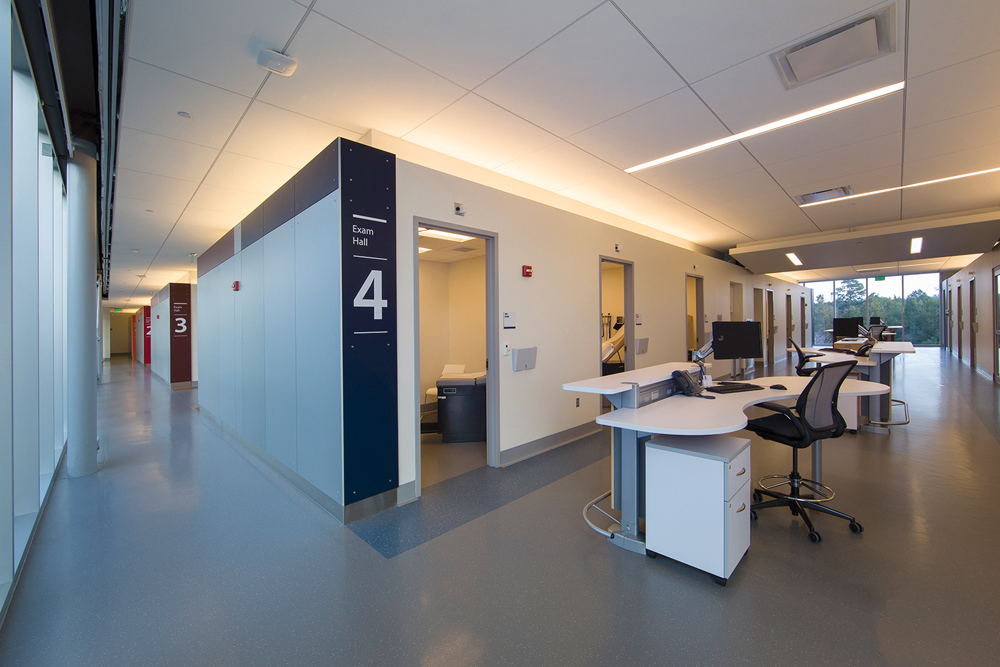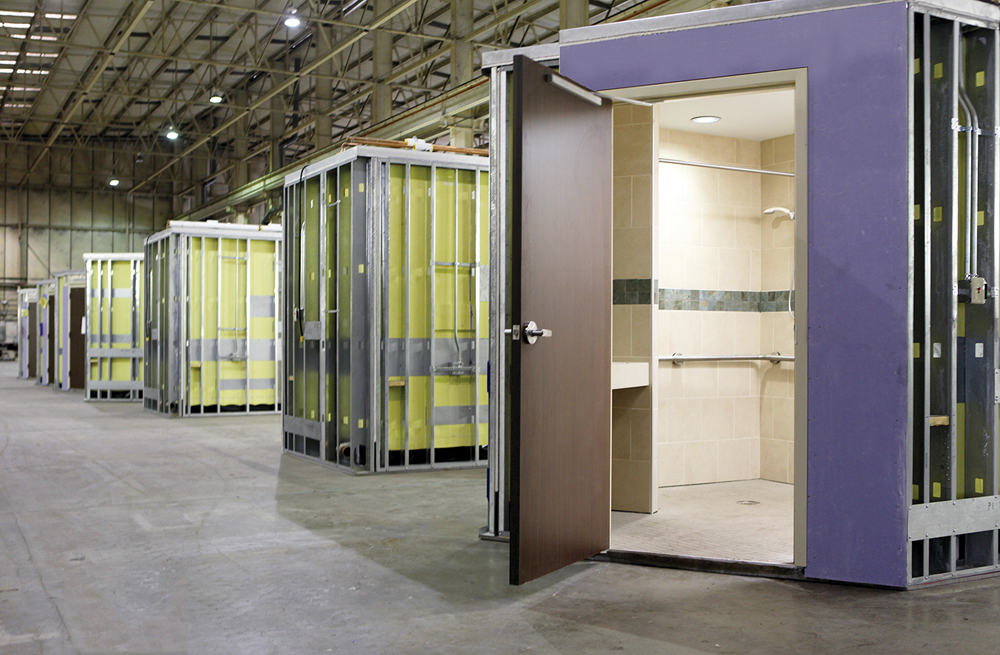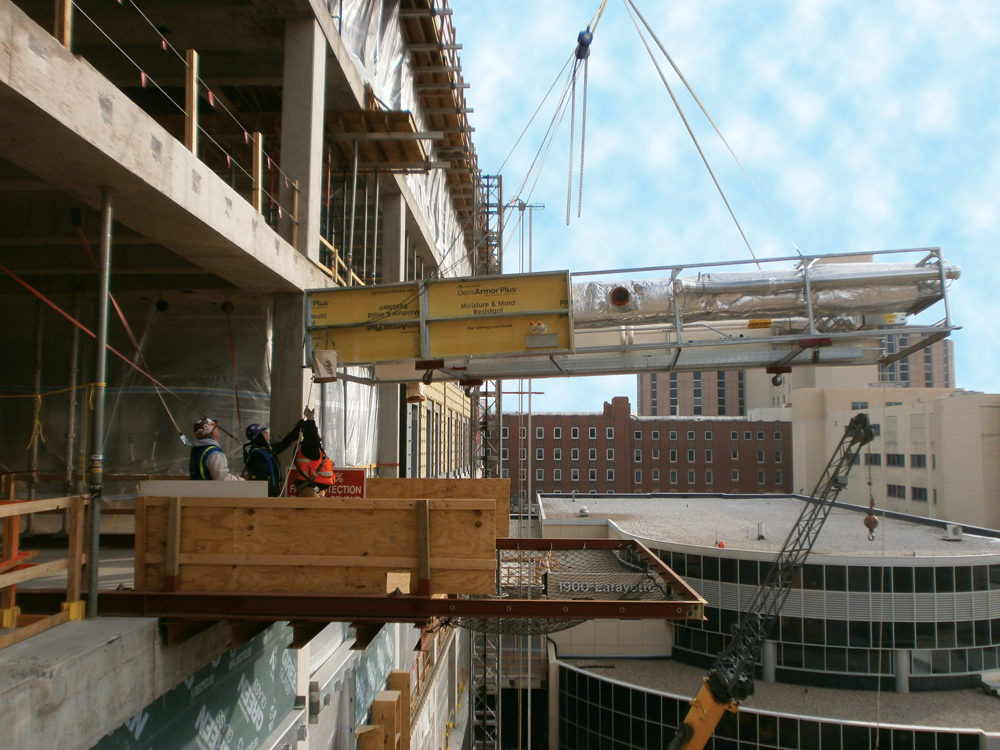Nick Pfenning thought he knew what fast track was before joining the Exempla St. Joseph Heritage Hospital project in Denver. As an eight-year construction management veteran with Mortenson Construction, Pfenning has worked on several tightly scheduled healthcare projects, including the 376,000-sf, $150 million Exempla Lutheran Medical Center, built in just 30 months.
But those efforts pale in comparison to what the Building Team is attempting with the St. Joseph’s project: 840,000 sf of program space, worth some $625 million, in less than 31 months.
“This isn’t fast track, this is psycho track, as far as the schedule goes,” says Pfenning, Assistant Superintendent in Mortenson’s Denver office.
Eight hundred miles southeast, in Dallas, another Building Team—led by Austin Commercial and Balfour Beatty, with Corgan and HDR as the design architects—is nearing completion on the nation’s largest public hospital construction project. This summer, less than four years after breaking ground, the 1.7 million-sf, $1.2 billion, 862-bed Parkland Replacement Hospital will be completed.
Both fast-track megaprojects—and dozens of smaller healthcare facilities across the U.S.—are being built in record time, thanks, in part, to the implementation of advanced multi-trade prefabrication techniques. By assembling components like MEP infrastructure, headwalls, bathrooms, patient rooms, and exterior elements offsite in a controlled environment, Building Teams are able to compress project schedules by performing multiple construction activities in parallel.

As more AEC firms overcome the learning curve of prefabrication, they’re starting to explore new opportunities for healthcare environments. Among the emerging prefab approaches are modular patient rooms and exam rooms. Pictured is a series of prefabricated exam rooms from medical modular manufacturer BLOX. Photo: BLOX
Take multi-trade racks, for example. At the St. Joseph project, the team is prefabricating overhead mechanical racks that house the hospital’s mechanical piping, ductwork, cable trays, electrical conduit, lighting conduit, and pneumatic tubing—basically everything but the fire sprinkler infrastructure.
Each 25-foot section is custom designed and fabricated (no two are alike), and shipped to the job site, where it is wheeled to its precise location and lifted into place. The process removes as many as 10 trades from the bustling job site and into the prefab warehouse nearby.
“I don’t know if there is any other way we could have met the schedule and have as many people working at the same time without prefabricating multiple components,” says Pfenning. “There are as many as 850 workers on the job site at any given time, and another 100 to 200 working off site.”
The schedule savings from prefabrication can be significant, exceeding six months in some cases. More importantly, prefab minimizes the risk of delays, says Timothy Krawetz, PE, LEED AP, Vice President with Syska Hennessy Group and head of the firm’s New York healthcare practice.
“The sooner they can move people in, the sooner the hospital can start generating revenue,” says Krawetz.
Multi-trade prefabrication applications for healthcare buildings
COMMON APPLICATIONS
Bathrooms (assembled components or pods)
Doors and door hardware packages
Exterior shell (curtain wall, precast concrete, etc.)
Headwall units
Multi-trade overhead MEP racks
Vertical chases
Wall assembliesEMERGING APPLICATIONSExam roomsMechanical roomsPatient roomsSources: BD+C, JE Dunn, Syska Hennessy Group
Added benefits of prefabrication include the potential for improved quality, better safety metrics, and less waste. But don’t expect upfront cost savings, say prefab experts: well-executed prefab efforts are typically cost-neutral.
And don’t expect the process to be easy, says Chris Giattina, Principal with Giattina Aycock Architecture Studio and CEO and Founder of BLOX, a manufacturer of medical modules. “Prefabrication requires more coordination by the team and, in most cases, fundamental changes to the way a traditional project team works,” says Giattina. “When it comes to prefab, most teams are still learning how to walk.”
We asked several leaders in prefabrication for their advice on implementing multi-trade prefabrication approaches on healthcare projects. Here’s what they said:
1. Don’t give up on prefab approaches if they don’t produce the desired results the first time.
Repetition and continual improvement are keys to success with prefabrication. Using prefab on components that have significant repeatability will allow efficiencies to kick in after the AEC team and the subcontractors climb the learning curve for the entire process, including design, BIM coordination, offsite fabrication, and onsite installation, says Chris Hermreck, PE, Project Manager with JE Dunn Construction, and a member of BD+C’s 40 Under 40 Class of 2013.

Bathroom pods have become a popular prefabrication approach for healthcare Building Teams because of the potentially sizable schedule savings. Case in point: The team for the Exempla St. Joseph Heritage Hospital in Denver reduced the project schedule by 10 weeks by prefabricating the facility’s 440 bathrooms. Pulling off bathroom pods can be tricky, however, say prefab experts, due to the extensive coordination required early in the design process. Photo: BLOX
“Once the trade contractors get into a rhythm, their efficiency will steadily increase, thus producing and installing components faster and with higher quality,” says Hermreck. “The challenge is identifying projects and components that have the right threshold of repeatability so that efficiencies can be achieved, especially if the project team is new to prefab.”
On large projects, says Hermreck, the team will gain efficiencies as the prefab implementation progresses. On a project with 100 prefab bathrooms, it may take the team 30 pods to get their technique down, so the schedule gains will be realized with the remaining 70 units.
2. Early collaboration of the team is absolutely paramount.
This statement is true for any project, but when implementing prefabrication approaches, collaboration of the entire Building Team at the earliest stages of design is vitally important. This means the contractor, subs, and even the prefab manufacturers should have a seat at the design table.
“Ideally, we want to be involved in the design—not necessarily programmatic, but at the very least in design development,” says Mike Austin, Senior MEP Project Manager with Skanska, who is currently managing the prefab work at the $1.2 billion University Medical Center in New Orleans. “We can better articulate to the designers what we want to prefabricate and what we think will deliver the most value.”
Virtual collaboration key to prefab success at Denver hospital project
At 840,000 sf, the Exempla St. Joseph Heritage Hospital in Denver is the nation’s largest private hospital construction project. The $625 million, 348-patient room facility is due to be completed this September, nearly six months ahead of the initial construction schedule.Working under a modified integrated project delivery (IPD) contract, the project’s Building Team—led by the joint design team of Davis Partnership, H+L Architecture, and ZGF, with Mortenson Construction as general contractor—is applying advanced, multi-trade prefabrication techniques to compress the schedule and achieve cost savings for the client.
By prefabricating the facility’s 440 bathrooms, for example, the team was able to shave 10 weeks off the original schedule. The bathroom pods were built in a factory nearly 2,000 miles away in Littleton, Mass., by Eggrock Modular Solutions. The hospital’s 166 overhead multi-trade MEP racks, 376 patient room headwalls, and 346 exterior panels were built in a controlled warehouse setting.
Shifting the construction of components off the job site and into a factory has its benefits, but this level of prefabrication requires extensive virtual collaboration with dozens of Building Team members in numerous locations.
To stay on track, the team is utilizing Bluebeam Software’s Revu PDF review platform and Studio cloud-based collaboration tool to host virtual coordination meetings. The software tools enable team members in multiple locations to review, mark up, and simultaneously comment on the same set of 2D and 3D PDF files.
“All of the Mortenson foremen and most of the subs’ foremen have tablets in the field, so we’re able to access the ‘one source of truth drawings’ on the fly,” says Nick Pfenning, Assistant Superintendent in Mortenson’s Denver office. “This is hugely important on this project, since construction is right on the heels of design.”
Using Revu and Studio, the construction team is able to track the progress of prefab components and deal with any problems that arise in real time.
“With each prefab element, we have an associated Bluebeam Studio session, where every piece and part is identified on the floor plan, along with a status update, whether it’s in fabrication, design, on the truck, installed, or there are questions,” says Pfenning. “It’s a huge coordination effort. Being able to get into the cloud and host online collaboration sessions with the latest plans has been valuable.”
Certain aspects of prefabrication can have significant impacts on the design, such as how walls are to be framed, the routing of mechanical and electrical systems, layout of interstitial spaces, and openings for components like headwalls.
3. Thoroughly evaluate the move-in path.
Extensive consideration should be given to the entire journey of prefab elements, from the offsite warehouse to the installed location in the building. Landing zones, equipment offloading, move-in paths through the structure, installation sequence, and pre- and post-installation procedures need to be hashed out well before the prefab components are built.
“Every detail needs to be scrutinized,” says JE Dunn’s Hermreck. “For instance, after a bathroom pod is set, how are the MEP contractors going to make the connections in tight areas near exterior walls or MEP chases? Planning the process will minimize potential surprises during installation, avoiding unforeseen cost and schedule impacts.”
Building Teams often apply 4D BIM modeling to determine the optimal path and installation sequence for prefab components. The software tool can also assist with timing the deliveries and installation to avoid interfering with other subcontractors working on the site.
4. Don’t forget to water test the bathroom pods.
It’s common for Building Teams to mock up bathroom pods for client walkthroughs and technical review by the team, but a full water test isn’t always standard practice.
Andy Frank, Construction Executive with Mortenson Construction, recommends hooking up the shower, faucet, and toilet as part of the mock-up testing. Test the electrical elements, too, including the lights.
“On a recent project, we discovered a drainage issue with the trench drain along the edge of the shower,” says Frank. “The fix was simple: We replaced the trench drain cover with a cover style that allowed for greater water flow. But it would have caused a much bigger headache after dozens of pods were installed.”
5. Expect a higher level of detail in the BIM model.
Spatial coordination is not enough for most prefab elements, according to Skanska’s Austin. The BIM model must also include the necessary content to be able to produce working drawings to support prefabrication.
“BIM is an incredibly powerful tool for validating spatial coordination, but it needs to be taken to a higher level to support fabrication,” says Austin.
In terms of the Level of Development Specification, Austin advises teams to aim for LOD 400 or better when modeling prefab elements. That means the model elements should be graphically represented within the model as a specific system, object, or assembly in terms of size, shape, location, quantity, and orientation, with detailing, fabrication, assembly, and installation information.
“Many models are at this level already,” says Austin. “Trade contractors and mechanical and electrical subs are creating their shop drawings and spool drawings directly from the BIM model. You just have to make sure it’s true to life.”
6. Be prepared to make design decisions much earlier.
Depending on the completeness of the prefabricated element, the client and design team will have to make firm design decisions and material choices much earlier in the planning process. It sounds simple enough, but owners and designers are not always ready to settle on wall colors, faucet styles, and flooring products during early design and planning, says Skanska’s Austin.
Bathroom pods, for instance, often come complete with lighting elements, wall and floor tile, and faucets and fixtures. Likewise, prefab headwalls must meet the décor and functional requirements of patient rooms and exam areas.
“We’re doing complete coordination of elements to a high level of fabrication detail well before the design team has developed the structure to support it,” says Austin. “While the design team and owner are still reviewing structural shop drawings, we’re submitting RFIs asking about mechanical components, color schemes, and product specifications. The process requires the owner and design team to make numerous decisions and choices early on—and to stick to them.”
7. Watch the connection locations of prefab components.
Depending on the project, the installation team for certain prefab elements, such as bathroom pods and headwalls, may have to deal with extremely tight working conditions. Poorly located connection points can make the problem worse, leading to schedule delays and potential installation challenges.
Mortenson’s Frank advises Building Teams to detail the connection locations and working conditions in the BIM model. “In the case of bathroom pods, allow for as many connections as possible to be near the edges of the module footprint,” says Frank. “This will minimize the amount of work required on top of and around the pod in potentially tight spaces.”
8. Be leery of prefabricating ADA-compliant bathrooms.
Building Teams, especially those new to prefab, may expose themselves to risk by overlooking ADA and other code-related constraints when building offsite. Factors such as ADA dimensional inaccuracies may not be discovered until after the pods are installed on site and the true building parameters and constraints become apparent.
“BIM should alleviate the majority of that concern, but it doesn’t catch everything,” says JE Dunn’s Hermreck. “Verify once and then verify again to minimize as many dimensional issues as possible. It’s challenging to foresee every potential issue, and a code issue is never something you want to find too late in the process.”
Related Stories
| Mar 21, 2011
RATIO Architects announces merger with Cherry Huffman Architects
RATIO Architects, Inc. with studios in Indianapolis and Champaign, Ill., recently announced it has merged with prominent Raleigh, N.C., firm Cherry Huffman Architects.
| Mar 18, 2011
Universities will compete to build a campus on New York City land
New York City announced that it had received 18 expressions of interest in establishing a research center from universities and corporations around the world. Struggling to compete with Silicon Valley, Boston, and other high-tech hubs, officials charged with developing the city’s economy have identified several city-owned sites that might serve as a home for the research center for applied science and engineering that they hope to establish.
| Mar 17, 2011
Perkins Eastman launches The Green House prototype design package
Design and architecture firm Perkins Eastman is pleased to join The Green House project and NCB Capital Impact in announcing the launch of The Green House Prototype Design Package. The Prototype will help providers develop small home senior living communities with greater efficiency and cost savings—all to the standards of care developed by The Green House project.
| Mar 17, 2011
Hospitality industry turns to HTS Texas for ‘do not disturb’ air conditioned comfort
Large resort hotels and hospitality properties throughout the Southwest have been working with local contractors, engineers and HTS Texas for the latest innovations in quiet heating, ventilating and air conditioning (HVAC) equipment. The company has completed 12+ projects throughout Texas and the Southwestern U.S. over the past 18 to 24 months, and is currently working on six more hotel projects throughout the region.
| Mar 16, 2011
AIA offers assistance to Japan's Architects, U.S. agencies coordinating disaster relief
“Our hearts go out to the people of Japan as a result of this horrific earthquake and tsunami,” said Clark Manus, FAIA, 2011 President of the AIA. “We are in contact with our colleagues at AIA Japan and the Japan Institute of Architects to offer not only our condolences but our profession's technical and professional expertise when the initiative begins focusing on rebuilding."
| Mar 16, 2011
Are you working on a fantastic residence hall project? Want to tell us about it?
The feature story for the May 2011 issue of Building Design+Construction will focus on new trends in university residence hall design and construction, and we’re looking for great projects to report on and experts to interview. Projects can involve new construction or remodeling/reconstruction work, and can be recently completed, currently under construction, or still on the boards.
| Mar 16, 2011
Foster + Partners to design carbon-neutral urban park for West Kowloon Cultural District in Hong Kong
Foster + Partners has been selected by the board of the West Kowloon Cultural District Authority to design a massive 56-acre urban park on a reclaimed harbor-front site in Hong Kong. Designed as a carbon-neutral development, “City Park” will seamlessly blend into existing streets while creating large expanses of green space and seventeen new cultural venues.
| Mar 15, 2011
What Starbucks taught us about redesigning college campuses
Equating education with a cup of coffee might seem like a stretch, but your choice of college, much like your choice of coffee, says something about the ability of a brand to transform your day. When Perkins + Will was offered the chance to help re-think the learning spaces of Miami Dade College, we started by thinking about how our choice of morning coffee has changed over the years, and how we could apply those lessons to education.
| Mar 15, 2011
What will the architecture profession look like in 2025?
The global economy and the economic recession have greatly affected architecture firms' business practices. A Building Futures survey from the Royal Institute of British Architects looks at how these factors will have transformed the profession and offers a glimpse of future trends. Among the survey's suggestions: not only will architecture firms have to focus on a financial and business approach rather than predominantly design-led offices, but also company names are predicted to drop ‘architect’ altogether.
| Mar 15, 2011
Passive Strategies for Building Healthy Schools, An AIA/CES Discovery Course
With the downturn in the economy and the crash in residential property values, school districts across the country that depend primarily on property tax revenue are struggling to make ends meet, while fulfilling the demand for classrooms and other facilities.











